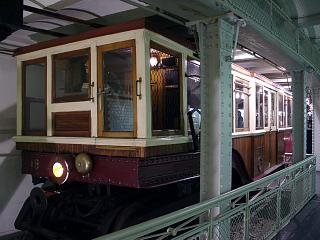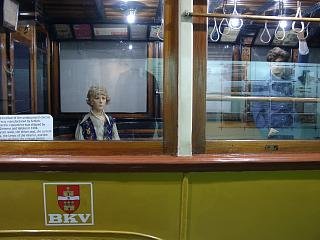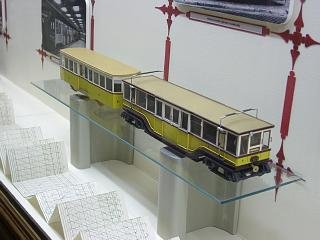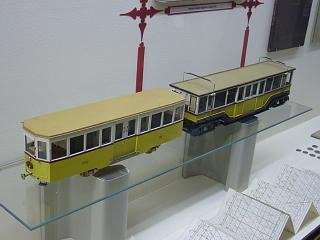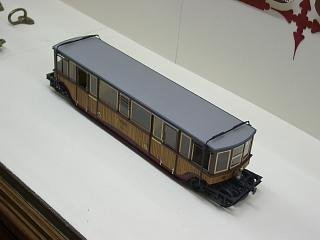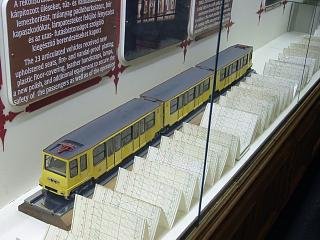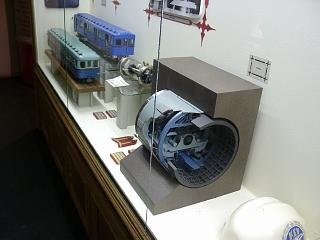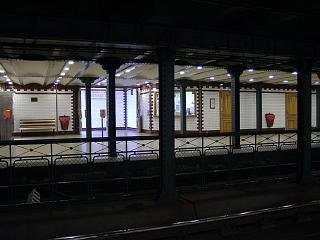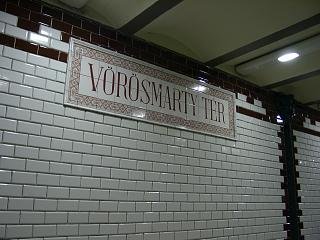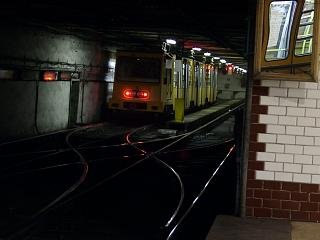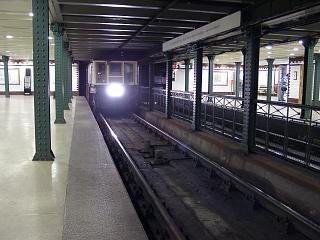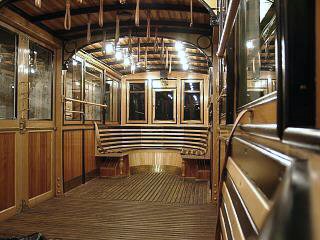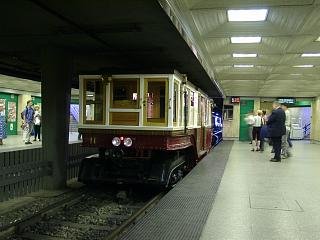Past and present meet
 The
Milleneum Subway Line was opened in 1896. Its name refers to the 1000th
anniversary of hungarian tribes settling on the ground that later became
Hungary. Budapest - capital of a country that was almost three times as
large then as it is today - has flourished in the last quarter of the 19th
century. With its recently developed metropolitan appeal it rivalled Vienna,
the imperial seat of the Austro-Hungarian Empire, and to show the
city's superiority in modern matters, an ambitous project was given green
light: an underground raiway line from the heart of the inner city to the
site of the Milleneum Fair in Városliget, a fashionable city park.
Andrássy
út (Sugár út at the time), an illustrious avenue leading from
the Small Boulevard to Városliget, was completed in 1876,
as a brand new major road designed with the most grand avenues of the world's
most grand cities in mind. Although PKVT, the Pest horse-tram company asked
for permission to build a horse-tram line here even before Andrássy út
was ready, their application was denied, because the Council for Communal
Works objected any kind of rail transportation on this new route. It was
in 1894 when BKVT and BVVV, the two biggest tram companies of Budapest
have jointly (!) submitted an application for an underground line under
Andrássy út, and the permission was granted!
The
Milleneum Subway Line was opened in 1896. Its name refers to the 1000th
anniversary of hungarian tribes settling on the ground that later became
Hungary. Budapest - capital of a country that was almost three times as
large then as it is today - has flourished in the last quarter of the 19th
century. With its recently developed metropolitan appeal it rivalled Vienna,
the imperial seat of the Austro-Hungarian Empire, and to show the
city's superiority in modern matters, an ambitous project was given green
light: an underground raiway line from the heart of the inner city to the
site of the Milleneum Fair in Városliget, a fashionable city park.
Andrássy
út (Sugár út at the time), an illustrious avenue leading from
the Small Boulevard to Városliget, was completed in 1876,
as a brand new major road designed with the most grand avenues of the world's
most grand cities in mind. Although PKVT, the Pest horse-tram company asked
for permission to build a horse-tram line here even before Andrássy út
was ready, their application was denied, because the Council for Communal
Works objected any kind of rail transportation on this new route. It was
in 1894 when BKVT and BVVV, the two biggest tram companies of Budapest
have jointly (!) submitted an application for an underground line under
Andrássy út, and the permission was granted!
 Construction
work started on August 7th, 1894 with the main contractors being Róbert
Wünsch (a well-known hungarian enterpreneur at the time) and Siemens et
Halske. The length of the line was 3.68 kilometers, of which 3.22 kilometers
ran under the surface. The 1435mm-gauge tracks were built with asymmetric
Vignol rails, the two overhead wires (which were in fact low-profile rails)
were electrified at 350 V DC. One big problem was the large sewer running
under the Grand Boulevard, that crossed Andrássy út at Oktogon.
The tunnel of the subway had to go over this sewer pipe - the substratum
here is very loose and digging a deep tunnel would have been very expensive,
if not impossible - and this posed a tough limitation: the bottom plate
of the tunnel was only 3.5 meters under the pavement! A matching vehicle
had to be designed. The car body and chassis was built by Schlick&Nicholson,
Budapest, the traction system came from Siemens et Halske.
Construction
work started on August 7th, 1894 with the main contractors being Róbert
Wünsch (a well-known hungarian enterpreneur at the time) and Siemens et
Halske. The length of the line was 3.68 kilometers, of which 3.22 kilometers
ran under the surface. The 1435mm-gauge tracks were built with asymmetric
Vignol rails, the two overhead wires (which were in fact low-profile rails)
were electrified at 350 V DC. One big problem was the large sewer running
under the Grand Boulevard, that crossed Andrássy út at Oktogon.
The tunnel of the subway had to go over this sewer pipe - the substratum
here is very loose and digging a deep tunnel would have been very expensive,
if not impossible - and this posed a tough limitation: the bottom plate
of the tunnel was only 3.5 meters under the pavement! A matching vehicle
had to be designed. The car body and chassis was built by Schlick&Nicholson,
Budapest, the traction system came from Siemens et Halske.
Service started on the 2nd of May, 1896. Although vehicles, electricity supplying and the safety system were altered over the years, the line has remained almost untouched until 1972-73, when the old surface section in Városliget was closed, and when the new vehicles built by Ganz-MÁVAG arrived. A new station at Széchenyi fürdő and a new terminus at Mexikói út was built as part of the extension. Although the characteristic "eastern bloc" design of these new stations was removed during the big renovation in 1996, the new section still differs from the rest of the line, which looks very much like the 1896 original.
Near the Deák Ferenc tér station there's a small museum for the Budapest underground system. It was set up in an abandoned section of the MillFAV tunnel, which was cut off in 1955, when the construction works for the second subway line have started. That time a few hundred meters of new tunnel and a new station was built. The old tunnel-fragment was taken in use again in 1975, when the Transportation Museum decided to open an exhibition just for the subway.
A couple of old cars were renovated, and the rest of the establishment was filled with old photos and remembrance. I think the decision was great: Deák Ferenc tér is where the city's three subway lines meet in an underground multilevel junction: the 1896 Milleneum Line - also called the Yellow Line or MillFAV for "Milleniumi Földalatti Vasút" -, M2 - the "east-west" or Red Line (opened in two steps in 1970 and 72) -, and M3, the "north-south" or Blue Line (opened in many steps between 1976 and 1990).
A little bit of history. Two batches of vehicles were ordered before the opening of the line, one by each of the two operators. Cars 1-10 were bought by the BVVV, 11-20 by the BKVT. Number 20 was a special car, built for the emperor and the royal family. The cars of the BKVT were - just like number 19 seen on the picture - covered by american mahogany, and had four B22/30 motors.
The cars of the BVVV were covered by metal sheets, and had four Siemens LDo motors. They were painted yellow...
... although what you see here is by no means the original condition, but how the car has ended its service in 1973. Originally both the BVVV and the BKVT cars (except for the royal car) had single-leaf sliding doors, which were replaced by double-leaf doors in the 1930's. The trucks were replaced twice: first in the 1930's and then at the end of the 1950's.
By the 1950's, the capacity of the old vehicles was insufficient, so FVV (the tram company between 1949/50 and 1967) has built 2-axle unpowered push-pull trailer cars.
Of course there is one such trailer displayed here! The equipment of the driver's cab came from the now unused "B" end of the old cars. The trailer cars have proven to be a bad design as they were harming the tracks, but even so they were used until the new cars arrived.
Another shot of that scale-modell.
This is a modell of "royal car" number 20. Unfortunately the original was destroyed in 1975.
The new Ganz-MÁVAG articulated subway cars were built for the reopening of the rebuilt and extended line in 1973, although 2 cars were built and tested as early as in 1971. The type is based on the Ganz CSMG2 articulated car, with new trucks, pneumatic brakes, and the electric equipment located in the articulation joints to produce a 470mm floor height. With an extra current collector to reach the overhead wire out in the streets, these cars can run on the tramway network, so I guess they were Budapest's first low-floor trams :-)
The two other "big" underground lines are also represented, although mostly by minatures: in the background you can make out scale-modells of the Ev and 81-717 series metro cars. In the foreground you can see a cut-away modell of a tunnel drill.
The stations on the old section (except for Deák Ferenc tér) all look pretty much like this.
I simple love this glazed tile wall-covering...
... and the riveted stanchions!
The double crossover at the end of the line.
And here's heritage car number 11 arriving at the Vörösmarty tér terminus!
The wooden interior of the car.
This car surrvived after 1973 as a battery-powered locomotive. In 1996 it was renovated for the 100th anniversary of the opening. Now it can be hired, but sometimes BKV organizes public rides, too. For example on the September 20th, 2003 everbody was invited to fill out a test about the line in the museum. If you got the answers right, you could participate on a round-trip from terminus to terminus and back again.
The outer end: Mexikó út, built in 1973. The typical "communist look" of the station was changed for a more mild design, but this old car still looks very anachronistic in this scenery!
Back to the opening page
HamPage


